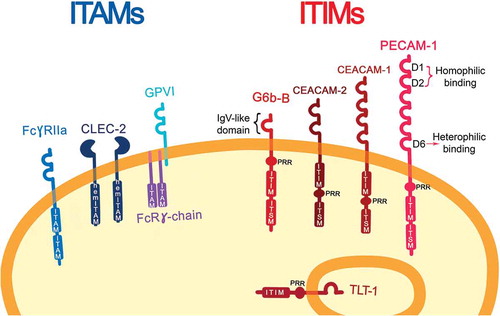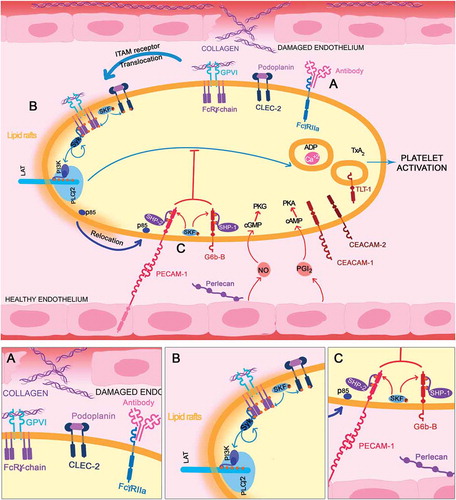Figures & data
Figure 1. ITAM- and ITIM-bearing receptors on resting platelets. Immunoreceptor tyrosine-based activation motif (ITAM)-bearing platelet receptors are represented on the left together with the hemITAM receptor, CLEC-2. On the right, immune-receptor tyrosine-based inhibitory-motif (ITIM)-bearing platelet receptors are shown with their characteristic features: IgV-like domains, one in the case of G6b-B and six on PECAM-1; a transmembrane domain (TMD), a proline-rich region (PRR), an immune-receptor tyrosine-based inhibitory-motif (ITIM), and an immune-receptor immunoreceptor tyrosine-based switch-motif (ITSM). On PECAM-1 D1 and D2 are implicated for homophilic interaction, meanwhile, D6 for heterophilic binding

Figure 2. ITAM-ITIM activation. (A) ITAM-bearing receptor (GPVI/FcRγ-chain/CLEC-2/FcγRIIA) are activated by their respective ligands (collagen/podoplanin/antibodies). (B) Receptors are then translocated to lipid rafts where SFKs phosphorylate them. Syk is recruited, activated, and subsequently propagates the signal through the LAT signalosome, where p85/p110 are recruited to form PI3K. This results in PLCγ2 activation and further platelet activation. (C) On the bottom, ITIM-bearing receptor activation (PECAM-1/G6b-B) recruits SFK, phosphorylating the ITIM/ITSM motifs, providing docking sites for the phosphatases (SHP1/2 and SHIP1/2). This results in relocation of molecules, such as p85, away from lipid rafts and therefore a reduction in the activation of Syk and the LAT signalosome, leading to platelet inactivation/maintenance of the resting state

Table I. Summary table comparing the main features of PECAM-1 and G6b-B
Table II. Summary table comparing PECAM-1 and G6b-B potential as therapeutic targets
